*Climate Data has been recorded at Barkley Regional Airport in West Paducah since 1949 and prior to that was observed in downtown Paducah back to December of 1937.
Veteran's Day is a United States holiday that honors people who have served in the U.S. Armed Forces, and is observed on November 11. President Woodrow Wilson first proclaimed Armistice Day for November 11, 1919, celebrating the end of World War I. It offically became a holiday in 1938. Armistice Day then evolved into the current Veterans Day holiday in 1954. For climate purposes, November 11th for the entire period of record will be used.
Here is a look at high and low temperature frequencies and extremes as well as precipitation statistics for Veteran's Day in Paducah.
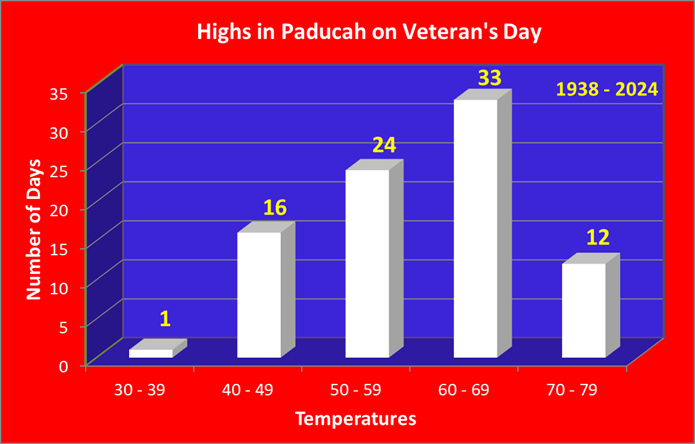
As seen by this graphic high temperatures are predominately in the 50s or 60s on Veteran's Day, encompassing 65% of all years on record.
| Warmest Highs | Coldest Highs |
| 79 in 1989 | 36 in 1941 |
| 78 in 2010 | 40 in 1996 |
| 75 in 1978 | 40 in 1976 |
| 75 in 1956 | 40 in 1968 |
| 72 in 2015 | 40 in 1950 |
| 72 in 1964 | |
| Normal High: | 61 |
Paducah has seen highs as warm as the 70s 12 times, most recently in 2016, when we topped out at 70 degrees. There has also been 1 year where the high temperature failed to reach 40 degrees, back in 1941.
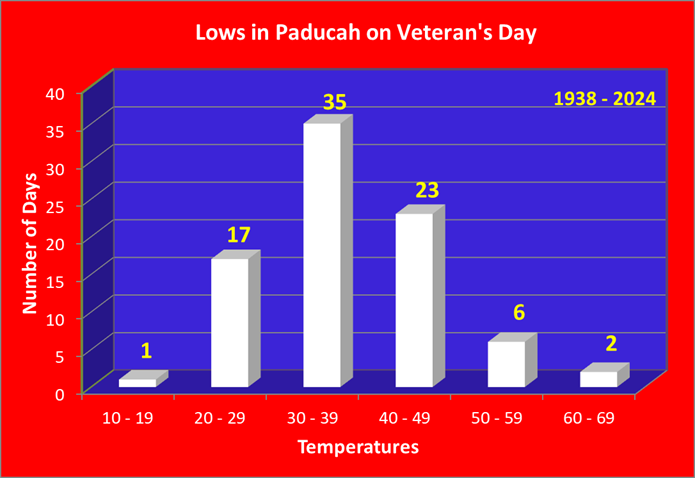
Low temperatures in the 30s are most common, accounting for 43% of all years on record. There are always exceptions to the norm of course: in 1960 the low temperature plummeted to 18 degrees, which is the only year with lows in the teens. On the warm side of the spectrum, there have been 2 years with lows staying in the 60s, back in 2003 and 1982.
| Warmest Lows | Coldest Lows |
| 62 in 1982 | 18 in 1960 |
| 60 in 2003 | 20 in 1950 |
| 58 in 1949 | 22 in 2018 |
| 55 in 1964 | 23 in 1957 |
| 53 in 2012 | 24 in 2019 |
| 24 in 1991 | |
| Normal Low: | 40 |
*Denotes a tie in previous year(s)
Measurable precipitation has fallen 27% of the time, with over an inch of precipitation falling on 3 different occasions, but this hasn't happened since 1967. The only year with measurable snow occurred in 2019 when
| Wettest (inches) | Snowiest (inches) |
| 2.18 in 1940 | 1.2 in 2019 |
| 1.50 in 1947 | |
| 1.15 in 1967 | |
| 0.94 in 2004 | |
| 0.68 in 1939 |
Here is a look at the observed weather for the past 15 years:
| Recent Veteran's Day Weather | |||
| Year | High | Low | Precip |
| 2010 | 78 | 41 | 0 |
| 2011 | 63 | 25 | 0 |
| 2012 | 71 | 53 | 0.55 |
| 2013 | 64 | 33 | 0 |
| 2014 | 62 | 34 | 0.06 |
| 2015 | 72 | 43 | 0.35 |
| 2016 | 70 | 37 | 0 |
| 2017 | 54 | 29 | 0 |
| 2018 | 49 | 22 | 0 |
| 2019 | 53 | 24 | 0.21 |
| 2020 | 61 | 41 | 0 |
| 2021 | 62 | 43 | 0.33 |
| 2022 | 59 | 37 | T |
| 2023 | 60 | 37 | 0 |
| 2024 | 69 | 45 | 0 |
*Climate Data has been recorded at Evansville Regional Airport since January of 1897. Snowfall records began in January of 1948.
Veteran's Day is a United States holiday that honors people who have served in the U.S. Armed Forces, and is observed on November 11. President Woodrow Wilson first proclaimed Armistice Day for November 11, 1919, celebrating the end of World War I. It offically became a holiday in 1938. Armistice Day then evolved into the current Veterans Day holiday in 1954. For climate purposes, November 11th for the entire period of record will be used.
Here is a look at high and low temperature frequencies and extremes as well as precipitation statistics for Veteran's Day in Evansville.
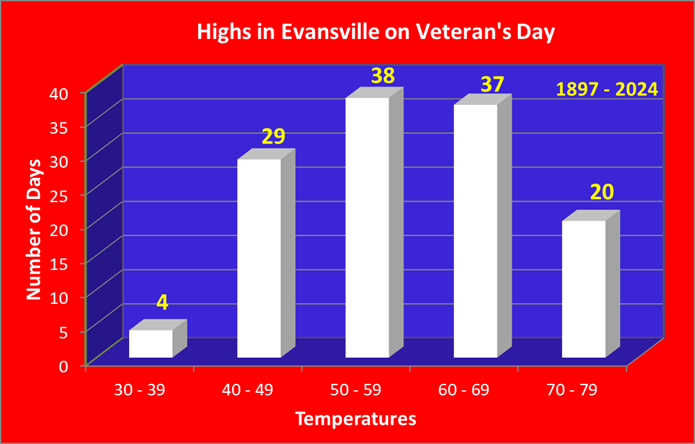
As seen by this graphic high temperatures are predominately in the 50s or 60s on Veteran's Day, encompassing 58% of all years on record.
| Warmest Highs | Coldest Highs |
| 79 in 2010 | 33 in 1932 |
| 77 in 1927 | 36 in 1996 |
| 76 in 1964 | 36 in 1950 |
| 76 in 1949 | 38 in 1976 |
| 76 in 1902 | 40 in 1968* |
| Normal High: | 59 |
*Denotes a tie in previous year(s)
Evansville has seen highs as warm as the 70s 20 times, most recently in 2010, when a record high of 79 degrees was set. There have also been 4 years where the high temperature failed to reach 40 degrees, most recently back in 1996.
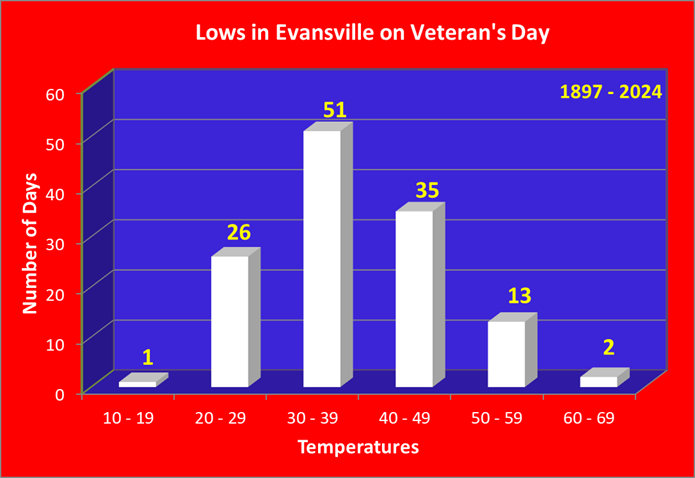
Low temperatures in the 30s or 40s are most common, accounting for 68% of all years on record. There are always exceptions to the norm of course: in 1960 the low temperature plummeted to 19 degrees, which is the only year with lows in the teens. On the warm side of the spectrum, there have been 2 years with lows staying in the 60s, back in 2003 and 1982.
| Warmest Lows | Coldest Lows |
| 63 in 1982 | 19 in 1960 |
| 60 in 2003 | 20 in 2018 |
| 59 in 1909 | 21 in 1957 |
| 59 in 1902 | 21 in 1950 |
| 58 in 1931 | 22 in 2019 |
| Normal Low: | 38 |
*Denotes a tie in previous year(s)
Measurable precipitation has fallen 32% of the time, with over an inch of precipitation falling on 5 different occasions, most recently in 2004. There have only been 2 years with measurable snow, with the most occurring in 2019 with 1.1 inches.
| Wettest (inches) | Snowiest (inches) |
| 2.14 in 2004 | 1.1 in 2019 |
| 1.27 in 1992 | 0.1 in 1995 |
| 1.23 in 1967 | |
| 1.11 in 1940 | |
| 1.03 in 1995 |
Here is a look at the observed weather for the past 15 years:
| Recent Veteran's Day Weather | |||
| Year | High | Low | Precip |
| 2010 | 79 | 39 | 0 |
| 2011 | 56 | 27 | 0 |
| 2012 | 69 | 55 | 0.21 |
| 2013 | 63 | 32 | 0.01 |
| 2014 | 62 | 35 | 0.02 |
| 2015 | 69 | 38 | 0.21 |
| 2016 | 68 | 40 | 0 |
| 2017 | 48 | 26 | 0 |
| 2018 | 45 | 20 | 0 |
| 2019 | 49 | 22 | 0.21 |
| 2020 | 58 | 38 | T |
| 2021 | 60 | 40 | 0.24 |
| 2022 | 59 | 34 | T |
| 2023 | 59 | 33 | 0 |
| 2024 | 66 | 43 | 0 |
*Climate Data has been recorded at Cape Girardeau Regional Airport, located 5 miles southwest of Cape Girardeau, since June of 1960.
Veteran's Day is a United States holiday that honors people who have served in the U.S. Armed Forces, and is observed on November 11. President Woodrow Wilson first proclaimed Armistice Day for November 11, 1919, celebrating the end of World War I. It offically became a holiday in 1938. Armistice Day then evolved into the current Veterans Day holiday in 1954. For climate purposes, November 11th for the entire period of record will be used.
Here is a look at high and low temperature frequencies and extremes as well as precipitation statistics for Veteran's Day in Cape Girardeau.
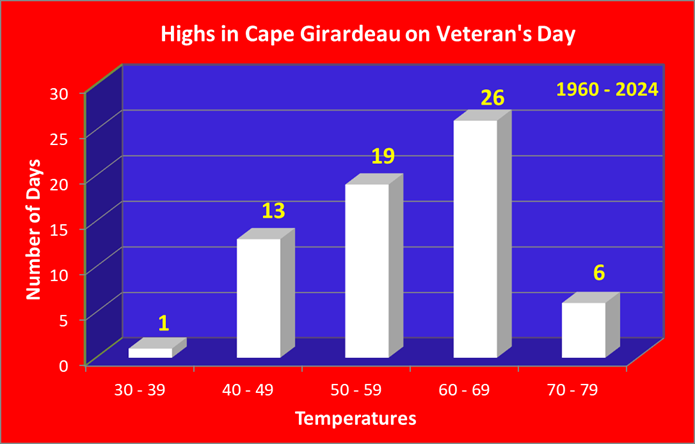
As seen by this graphic high temperatures are predominately in the 50s or 60s on Veteran's Day, encompassing 67% of all years on record.
| Warmest Highs | Coldest Highs |
| 77 in 2010 | 39 in 1996 |
| 76 in 1989 | 40 in 1976 |
| 75 in 1978 | 41 in 1986 |
| 73 in 1964 | 41 in 1984 |
| 72 in 2012 | 41 in 1968 |
| Normal High: | 60 |
Cape Girardeau has seen highs as warm as the 70s 6 times, most recently in 2012, when a warm 72 degrees occurred. There has also been 1 year where the high temperature failed to reach 40 degrees, back in 1996.
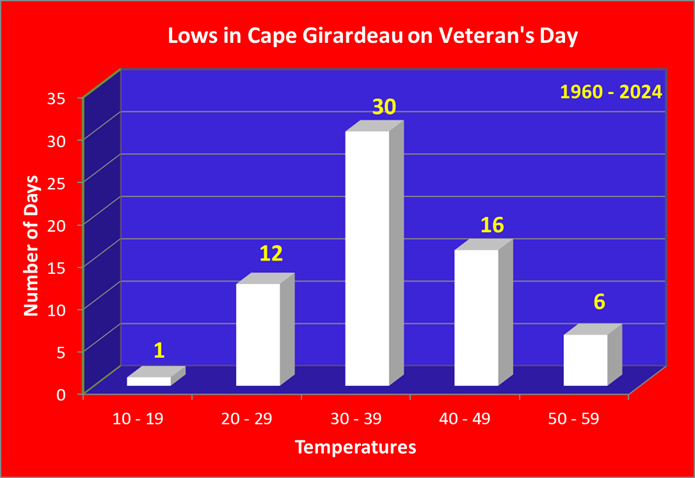
Low temperatures in the 30s are most common, accounting for 48% of all years on record. There are always exceptions to the norm of course: in 1960 the low temperature plummeted to 18 degrees, which is the only year with lows in the teens. On the warm side of the spectrum, there have been 6 years with lows staying in the 50s, with the warmest occurring in 1982 when a mild low of 59 degrees occurred.
| Warmest Lows | Coldest Lows |
| 59 in 1982 | 18 in 1960 |
| 56 in 2003 | 22 in 2019 |
| 53 in 1964 | 23 in 2018 |
| 52 in 1992 | 24 in 1976 |
| 51 in 2012 | 26 in 2011 |
| 26 in 1995 | |
| 26 in 1973 | |
| Normal Low: | 38 |
Measurable precipitation has fallen 27% of the time, with over an inch of precipitation falling on 3 different occasions, most recently in 2021.
| Wettest (inches) |
| 1.28 in 2004 |
| 1.20 in 2021 |
| 1.07 in 1992 |
| 0.91 in 1995 |
| 0.86 in 2012 |
Here is a look at the observed weather for the past 15 years:
| Recent Veteran's Day Weather | |||
| Year | High | Low | Precip |
| 2010 | 77 | 44 | 0 |
| 2011 | 61 | 26 | 0 |
| 2012 | 72 | 51 | 0.86 |
| 2013 | 62 | 33 | T |
| 2014 | 59 | 34 | 0.04 |
| 2015 | 69 | 44 | 0.57 |
| 2016 | 68 | 33 | 0 |
| 2017 | 51 | 29 | 0 |
| 2018 | 48 | 23 | 0 |
| 2019 | 53 | 22 | 0.24 |
| 2020 | 58 | 36 | 0.09 |
| 2021 | 63 | 43 | 1.20 |
| 2022 | 55 | 36 | T |
| 2023 | 60 | 34 | 0 |
| 2024 | 69 | 42 | 0 |
Climate Data has been recorded at the Poplar Bluff Airport, located 4 miles east of Poplar Bluff, since December of 1997. Prior to that data was taken at the Poplar Bluff COOP station, located a half mile west of downtown. Data for the COOP station dates back to January 1893.
Veteran's Day is a United States holiday that honors people who have served in the U.S. Armed Forces, and is observed on November 11. President Woodrow Wilson first proclaimed Armistice Day for November 11, 1919, celebrating the end of World War I. It offically became a holiday in 1938. Armistice Day then evolved into the current Veterans Day holiday in 1954. For climate purposes, November 11th for the entire period of record will be used.
Here is a look at high and low temperature frequencies and extremes as well as precipitation statistics for Veteran's Day in Poplar Bluff.
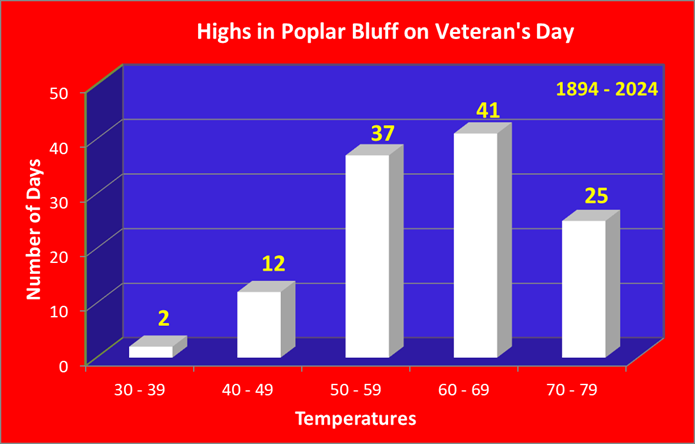
As seen by this graphic high temperatures are predominately in the 50s or 60s on Veteran's Day, encompassing 66% of all years on record.
| Warmest Highs | Coldest Highs |
| 79 in 1933 | 37 in 1894 |
| 79 in 1927 | 38 in 1968 |
| 79 in 1902 | 42 in 1973 |
| 78 in 1956 | 42 in 1950 |
| 78 in 1915 | 44 in 1996 |
| Normal High: | 60 |
Poplar Bluff has seen highs as warm as the 70s on 25 occasions, most recently in 2024. There have also been 2 years where the high temperature failed to reach 40 degrees, back in 1968 in 1894.
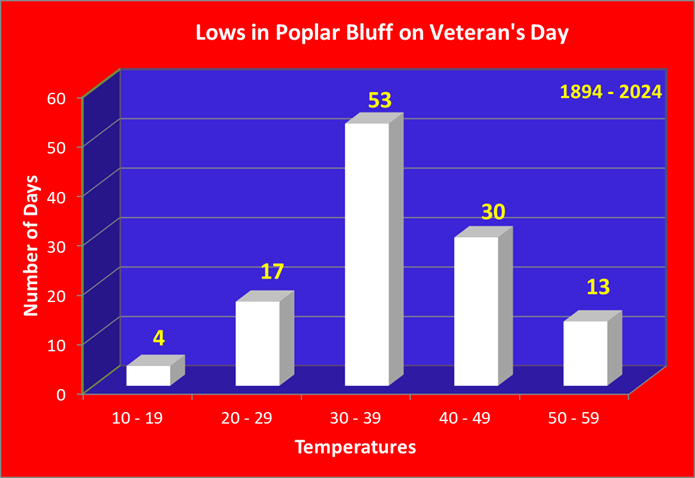
Low temperatures in the 30s are most common, accounting for 45% of all years on record. There are always exceptions to the norm of course: in 1950 the low temperature plummeted to 17 degrees, which is one of four years with lows in the teens. On the warm side of the spectrum, there have been 13 years with lows staying in the 50s, most recently occurring in 2012.
| Warmest Lows | Coldest Lows |
| 56 in 1927 | 17 in 1950 |
| 56 in 1902 | 18 in 1960 |
| 56 in 1901 | 19 in 1926 |
| 53 in 2003 | 19 in 1894 |
| 53 in 1931 | 21 in 1957 |
| Normal Low: | 38 |
Measurable precipitation has fallen 23% of the time, with over an inch of precipitation falling on 4 different occasions, most recently in 2012.
| Wettest (inches) |
| 1.55 in 1995 |
| 1.37 in 2004 |
| 1.28 in 1974 |
| 1.23 in 2012 |
| 0.93 in 1967 |
Here is a look at the observed weather for the past 15 years:
| Recent Veteran's Day Weather | |||
| Year | High | Low | Precip |
| 2010 | 77 | 44 | 0 |
| 2011 | 64 | 28 | 0 |
| 2012 | 73 | 52 | 1.23 |
| 2013 | 65 | 35 | T |
| 2014 | 58 | 31 | T |
| 2015 | 69 | 42 | 0.43 |
| 2016 | 72 | 37 | 0 |
| 2017 | 51 | 30 | 0 |
| 2018 | 47 | 24 | 0 |
| 2019 | 47 | 23 | 0.28 |
| 2020 | 60 | 41 | 0.06 |
| 2021 | 65 | 41 | 0.80 |
| 2022 | 57 | 37 | 0.01 |
| 2023 | 55 | 37 | 0 |
| 2024 | 71 | 45 | 0 |